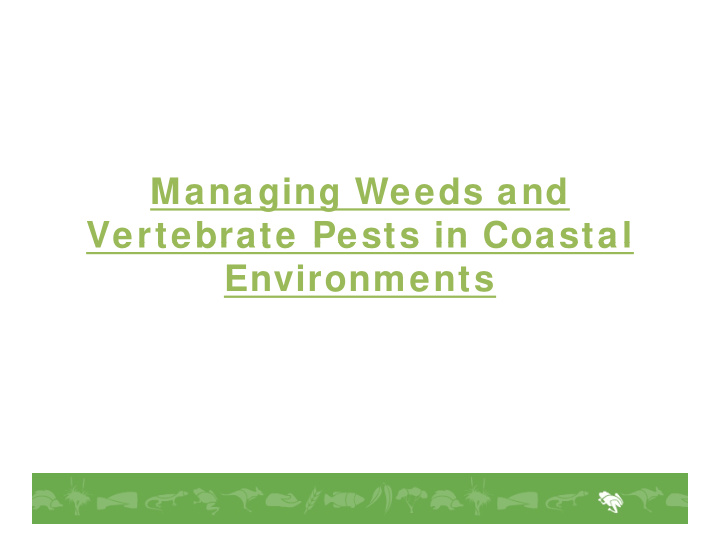



Managing Weeds and Vertebrate Pests in Coastal Vertebrate Pests in Coastal Environments
Land owner Responsibilities Land owner Responsibilities • 182—Owner of land to take action to destroy or control animals or plants • • (1) Subject to this section an owner of land within a control area for a class of animals or (1) Subject to this section, an owner of land within a control area for a class of animals or • plants to which this subsection applies must destroy all animals or plants of that class • on that land. • (2) Subject to this section, an owner of land within a control area for a class of animals or • plants to which this subsection applies must control and keep controlled all animals or p pp p • plants of that class on that land. • (3) An owner of land within a control area for a class of animals or plants to which this • subsection applies must— • (a) take any measures prescribed by the regulations or specified by a relevant • authority in the prescribed manner for the control of all animals or plants of • that class that are, or may be, on that land; • (b) take any measures prescribed by the regulations or specified by a relevant • authority in the prescribed manner requiring that the land, or anything present • • on the land be subjected to specified treatment on the land, be subjected to specified treatment.
Proclaimed Winter Weeds • False Caper • Salvation Jane • Horehound • Cape Tulip p p • African Boxthorn • Bridal Creeper Bridal Creeper
Proclaimed Environmental Weeds Proclaimed Environmental Weeds AFRICAN BOXTHORN Lycium ferocissimum Boxthorn is spread into natural areas and pasture by birds and foxes. Boxthorn re ‐ sprouts readily from roots left in the ground if not poisoned or removed in the ground if not poisoned or removed completely Prevention is the most cost ‐ effective form of weed control. For established infestations in native vegetation, a carefully planned, long ‐ term program is needed to eliminate boxthorn with minimum disturbance with minimum disturbance
Proclaimed Environmental Weeds Bridal Creeper is an aggressive creeper from South Africa. It is widespread throughout south ‐ eastern Australia and is a declared plant h l d d l d l under the Natural Resource Management Act 2004 . In 2003 another form of Bridal Creeper was p discovered in the vicinity of Port MacDonnell. This variety is more vigorous with tougher leathery leaves and a larger tuberous mass. Bi l Biological controls have so far been i l t l h f b unsuccessful on this variety.
Non Proclaimed Problem Weeds Non Proclaimed Problem Weeds • Shiny Leaf Coprosma • Polygala P l l • Gazania • Apple of Sodom • Apple of Sodom • Italian Buckthorn • Scabiosa • Scabiosa • Spiny Rush
Spiny Rush Juncus acutus Native to Europe, Africa and the Americas Naturalised in Victoria Americas. Naturalised in Victoria, Western Australia, South Australia, New South Wales and New Zealand. A serious environmental weed and A serious environmental weed and declared noxious weed for Victoria. Widespread in damp places and infrequently inundated q y watercourses on the coast and inland. The sharp spines, that project at many angles, make it especially dangerous for children.
Knobby club rush Isolepis nodosa l d This perennial rush has This perennial rush has clumps of dark green stems on long creeping rhizomes. hi It grows to a height of 30 ‐ 90 cm.
What is a Pest Animal? Vertebrate Pests • Rabbits Fox • • Deer ssp • • Goats Goats • Pigs Pest Animal Issues • Impacts on Native species • Losses to Primary production • Spread of weeds and disease S d f d d di • Legislative requirements • Issues with responsibilities • Costs associated with control
Impacts on the Environment • Out competing native animals • Out competing native animals • Damage to native fauna • Damage to native flora • Erosion issues Control Methods • Poisons • Trapping • Shooting • Fumigation • Fumigation
Weed Control Methods d l h d • Chemical • Mechanical • Biological
Planning and Implementing a Control Program Know your weeds and vertebrate pests. • • Map of property • Timing of control (Seasonal) • Long term Planning • Monitoring Neighbours Neighbours • • • Contacts
Managing Weeds and Managing Weeds and Vertebrate Pests in Coastal Environments Questions? Roger Davidson Authorised Officer Authorised Officer South East Natural Resources Management Board Tel: 08 87672077 Mob: 0428 856 478 Mob: 0428 856 478
Recommend
More recommend